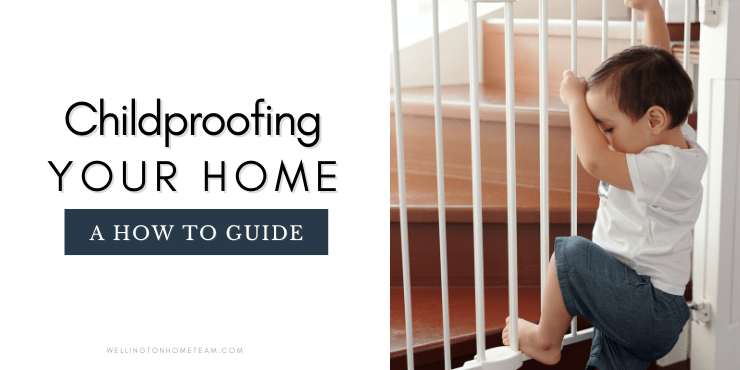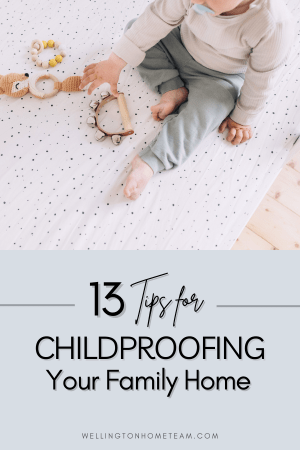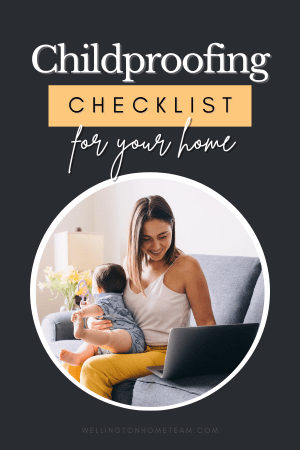Childproofing Your Home: A Comprehensive How-To Guide
Small children tend to be curious and like to explore their surroundings. Unfortunately, they also have no idea what’s dangerous until it’s too late. To minimize the risk of injuries and accidents, it’s imperative to be thorough when childproofing your home. Begin by identifying potential hazards, checking each room thoroughly, and considering what may present a risk to your child’s safety. Once you’ve identified the potential hazards in your home, you can take the necessary steps to minimize or eliminate the risks posed.

Address the Big Hazards First
Attend to the larger, more pressing hazards first. For example, any broken windows should be fixed, and it’s recommended to set your hot water to below 120 F to avoid the risk of bath water being scalding. If your home is an older one, it’s a good idea to check if there is any lead paint on the doorframes or windowsills.
Once the big risks are dealt with it’s time to get methodical and drill down into the nitty gritty detail where many risks unfortunately lurk. Owning your home will make some of these steps easier to carry out, although it’s fair to say that children’s safety surely trumps the need to have a handyman fix up some rental property alterations when it’s time to move on.
Childproofing Tips & Considerations
There’s no end to the mischief children can get themselves into, and every home environment will pose its own set of unique risks. It’s vital that you conduct a thorough assessment of your particular home and identify any and all hazards that need to be addressed. Here are some of the main areas to consider from a general point of view for childproofing your home:
Smoke Detectors
Ensure that properly working smoke detectors are fitted in each bedroom and common area, on every floor of your home; carbon monoxide alarms are also essential. If you already have these devices in place, make sure they are in working order.
Electrical Outlets
To keep curious little fingers safe from electrical outlets, an easy way to childproof them is to use safety plugs or outlet covers. These plugs are fairly inexpensive and are a must when childproofing your home.
 Curtain and Blind Cords
Curtain and Blind Cords
Curtains and window blinds may have loose cords, which pose a strangulation risk for young children. An easy solution is to keep these cords out of children’s reach by securing them beyond their reach and ensuring that they are repositioned as such after each use. Ideally, if you’re able to change to cordless window coverings, you won’t have the worry of low-hanging cords.
Furniture Corners
A common risk is that of furniture with sharp edges and corners, as they can cause serious injury to children when accidentally crashed into. Edge protectors and corner guards provide a soft cushion to the edges, reducing the risk of severe harm.
Sharp Objects
Safety sheaths to cover sharp objects such as scissors and knives add an extra layer of protection but still keep these items locked away whenever not in use by an adult. This step should not be skipped when childproofing your home.
Lock it Up
Locking drawers and cabinets is easier than you may think. Installing child-proof latches or locks will prevent children from reaching dangerous items.
Keep your chemicals, cleaning supplies, medications, and sharp objects out of reach. For added safety keep your medications in a secure container, and dispose of any out-of-date medications safely – medications can look like candy to young eyes and must be stored securely and out of sight at all times.
It’s the Little Things
Routinely check for small objects left around in children’s reach, such as coins, batteries, and buttons, that could be a choking hazard.
Bathroom Safety
Keep the bathroom door shut to prevent young children from playing with water. To avoid access when not in use, install toilet seat latches or locks. You’ll not only be saving yourself a call with the plumber to retrieve flushed items, but also reduce the risk of water-related injury.
Kitchen Safety
It’s important to never leave the kitchen unsupervised when you’re cooking. Oven locks and stove guards help, but make sure to keep items out of reach and saucepan handles turned away from the edge to prevent your child from grabbing the handle and tipping it towards themselves.
 Stairs and No-Go Areas
Stairs and No-Go Areas
Installing safety gates at stairs and balconies greatly reduces the danger to young children who may unwittingly stumble or fall. These physical barriers can also prevent access to other hazards, such as a craft room, where keeping all potential dangers packed away is a little harder to achieve.
Make sure to choose a safety gate that can be securely mounted to door frames or walls and meets safety standards, and consider the safety of stair railings. Safety gates are a must when childproofing your home even if you have a one-story home.
Windows
Window locks and window guards prevent children from opening windows and possibly falling; if you have a balcony, you’ll want to make sure the railing is childproofed.
Heavy-Duty Items
Securing heavy appliances and furniture is a must as they are a tipping risk. Ensure you anchor bookshelves, cabinets, and other heavy furniture to the wall. Brackets or furniture straps should keep them steady. Lighter appliances, such as televisions, are also a tipping risk and should be secured well.
Security
Installing a security system with all the bells and whistles may seem like a large cost, but investing in one provides an extra layer of invaluable protection. Still, if a big, fancy security system isn’t in your budget (and with a young child, you’ve got a million other expenses to contend with), consider installing IP security cameras to act as a deterrent. This is a great addition to add when childproofing your home.
Creating a Designated Play Zone
If you have the space, you may want to think about creating a playroom for your child that is free from hazards, (your dream billiard table might have to wait). Safety gates can then be used to prevent your child from exploring the rest of the house unsupervised. Designated play zones that are set up for ultimate safety are a fantastic way to gain some peace of mind (and a minute to breathe!). If you don’t have a spare room to dedicate to this, you may want to section off part of a room instead – it’s worth it.
Final Thoughts
When your child is old enough, it’s important to get them involved in safety around the home. You can teach them about all the possible hazards, such as not climbing on furniture, not touching the stove, or poking things into electrical outlets – try to make it fun while ensuring that they understand the severity of the subject. Until that time, the more prepared your house is for kiddy-friendly exploration, the easier your days will be. So childproofing your home is essential.
Please consider spreading the word and sharing; Childproofing Your Home: A Comprehensive How-To Guide
Popular Questions About Childproofing Your Home
Should you babyproof your house? Yes, it is highly recommended to babyproof your house. It helps prevent accidents, injuries, and potential hazards that may be present in a typical household. By installing safety gates, securing furniture, covering electrical outlets, locking cabinets, and removing choking hazards, you can significantly reduce the risk of accidents and provide a secure space for your child to explore and play.
When should I start baby proofing my house? It is recommended to start baby-proofing your house before your baby begins to crawl and can independently explore their surroundings. This typically occurs around six to eight months of age, however, every child develops at their own pace.
Childproofing your home prior to your baby becoming mobile certainly won’t hurt anything. In fact, it’ll actually give you more time to take the necessary precautions to create a safe environment for your little one. Then as your baby grows and becomes more active, you can continue to adapt and enhance your baby-proofing measures to meet their changing needs.
When can you stop babyproofing your home? The timeline for when to stop babyproofing your home varies for each child and depends on their developmental progress and individual behavior. Generally, you can consider reducing or eliminating babyproofing measures as your child grows older, becomes more aware of their surroundings, and develops better coordination and judgment. It is typically around the age of 2 or 3 that children start to understand and follow basic safety rules. However, it’s important to remember that every child is different, and you should continuously assess the safety of your home based on your child’s abilities and behaviors.
About the Author
Top Wellington Realtor, Michelle Gibson, wrote: “Childproofing Your Home: A Comprehensive How-To Guide”
Michelle has been specializing in residential real estate since 2001 throughout Wellington Florida and the surrounding area. Whether you’re looking to buy, sell, or rent she will guide you through the entire real estate transaction. If you’re ready to put Michelle’s knowledge and expertise to work for you call or e-mail her today.
Areas of service include Wellington, Lake Worth, Royal Palm Beach, Boynton Beach, West Palm Beach, Loxahatchee, Greenacres, and more.
Childproofing Your Home: A Comprehensive How-To Guide
- SEO Powered Content & PR Distribution. Get Amplified Today.
- PlatoData.Network Vertical Generative Ai. Empower Yourself. Access Here.
- PlatoAiStream. Web3 Intelligence. Knowledge Amplified. Access Here.
- PlatoESG. Automotive / EVs, Carbon, CleanTech, Energy, Environment, Solar, Waste Management. Access Here.
- BlockOffsets. Modernizing Environmental Offset Ownership. Access Here.
- Source: https://wellingtonhometeam.com/childproofing-your-home-how-to-guide/



